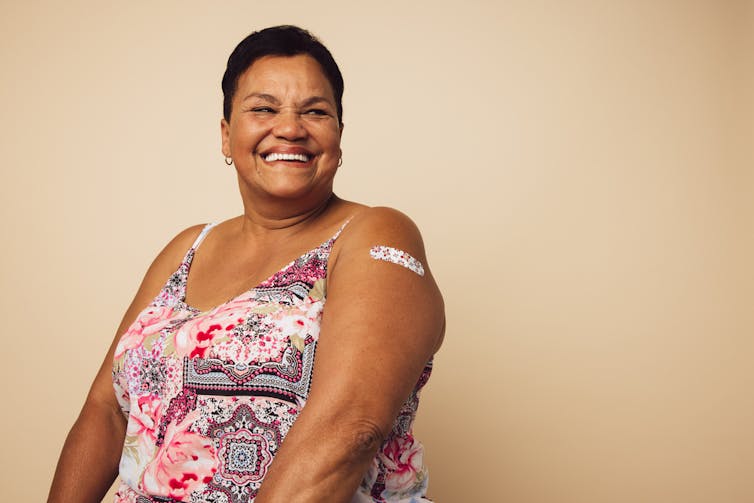
The rapid development and deployment of COVID vaccines has been one of the greatest achievements of the pandemic.
However, Australia risks relying on COVID vaccines from two main companies – Pfizer and Moderna – and that’s a problem.
While the need for COVID vaccines is not going away anytime soon, we need to shape the market to drive more competition for better access to improved vaccines.
Here’s what Australia needs to do to break free from an effective duopoly dominating the local market, especially when many of us are likely to need boosters.
Read more: COVID vaccination recommendations evolve over time. Who is due for which dose now?
How did we get here?
When COVID finally broke out at scale in Australia late last year, the vaccines (and high levels of adult vaccination) worked extremely well to reduce deaths and severe illness.
Since January 1 this year, there have been more than 5.9 million confirmed COVID infections nationwide, but about 5,300 deaths.
Yet current vaccines aren’t 100% effective at protecting against infection; new viral variants (and sub-variants) continue to emerge; protection via vaccination and prior infection wanes quite quickly, meaning reinfection is becoming more common and booster shots may remain part of the landscape for some time to come.
Meanwhile, vaccine inequity remains an unresolved problem. This has led to a situation where rich countries, such as Australia, are giving booster shots where some poorer countries don’t even have enough vaccine for first doses.
Read more: How Australia's fickleness on COVID vaccines is perpetuating global vaccine inequity
Pfizer and Moderna, but not much else
In a recent article in the Medical Journal of Australia, we outline the need to break free from the handful of powerful players still dominating Australia’s COVID vaccine market.
While the number of approved COVID vaccines is growing around the world, Australia largely still relies on only two, namely vaccines from Pfizer and Moderna.
The AstraZeneca and Novavax vaccines are only rarely used as boosters if no other vaccines are suitable.
More than 95% of Australian adults have received two doses of COVID vaccine already. So future requirements are primarily for boosters and child vaccines. Australia, therefore, continues to face an effective duopoly.

The power of patents
This effective duopoly further reinforces the already considerable power these manufacturers hold via the intellectual property rights to their vaccines.
These vaccine patents are protected by the World Trade Organization under the Agreement on Trade-Related Aspects of Intellectual Property Rights (or TRIPS). This prevents international competitors from replicating patented technologies.
These patent rights allow companies to earn higher profits (or “economic rents”) than if their technologies were freely available to allow open competition.
The intellectual property dimensions of COVID vaccines have been controversial.
Pfizer and Moderna have continued to make extraordinary profits from COVID vaccines.
Yet Moderna found itself in dispute with the United States government, conceding US government employees had directly developed several technologies key to the Moderna vaccine (not to mention years of publicly-funded basic research).
Moderna has also resisted sharing the formulation of its vaccine to allow key middle-income countries to manufacture it.
Meanwhile, Pfizer has negotiated advantageous and secretive vaccine contracts with governments, shifting liability and risk onto governments and controlling nations’ ability to redistribute stock between themselves.
High-income countries have consistently resisted or watered down calls for a TRIPS waiver, which would have allowed global sharing of manufacturing technologies.
Critics argue the opponents of a TRIPS waiver are largely concerned about avoiding setting any precedents that might allow the profits of Big Pharma to be limited in future.
What should Australia do next?
In Australia, the reality that current COVID vaccines only partially prevent transmission leaves us dependent on this effective duopoly for ongoing boosters. Boosters also remain mandated for people in many occupations.
Australia can escape this captive vaccine market in three steps.
1. Approve more vaccines
Australia needs to expand the supply of new COVID vaccines by actively assisting a wider range of manufacturers to bring their products to the Therapeutic Goods Administration for approval. This would increase competition for boosters and stimulate the development and supply of more effective “sterilising” vaccines (ones that prevent viral transmission).
Meanwhile, Australia must extract maximum value from all existing vaccine contracts, and insist upon full freedom to transfer supplies to our regional neighbours.
2. Push for patent reform
Australia should use its influence to vigorously drive a TRIPS waiver at the World Trade Organization. It should also explore strategic options with a coalition of partners to consider how the current global intellectual property regime could be rapidly reformed or, if necessary, circumvented.
Read more: 3 ways to vaccinate the world and make sure everyone benefits, rich and poor
3. Set up domestic, not-for-profit capability
Australia should institute an economic “mission” to establish publicly-owned, not-for-profit vaccine and essential pharmaceuticals research, development and manufacturing infrastructure and capability in Australia. This would serve domestic and wider regional needs for COVID and beyond.
Sadly, the Australian government’s recent agreement with Moderna for the company to establish mRNA manufacturing here is not such an example. It may risk entrenching existing power. The agreement is also still secret.
Read more: New facility to be built in Victoria to produce mRNA vaccines
In an increasingly insecure world of growing disruptions – ecological and health crises, fracturing supply chains and heightened military tensions – Australia can provide a safe and resilient vaccine and pharmaceutical manufacturing capability to protect the health of Australians and our neighbours.
However, old models that privilege shareholders, via excess profits and intellectual property protection, will not deliver this new vision.
Sithara Dona, an associate research fellow at Deakin University, co-authored the research mentioned in this article.
Martin Hensher has received an honorarium from Novartis SA (Brazil) for a lecture delivered to the Novartis Access 2021 conference. He is a member of the South Australian Health Performance Council and a board member of Glenview Community Services, Tasmania (a not-for-profit aged care provider).
This article was originally published on The Conversation. Read the original article.







